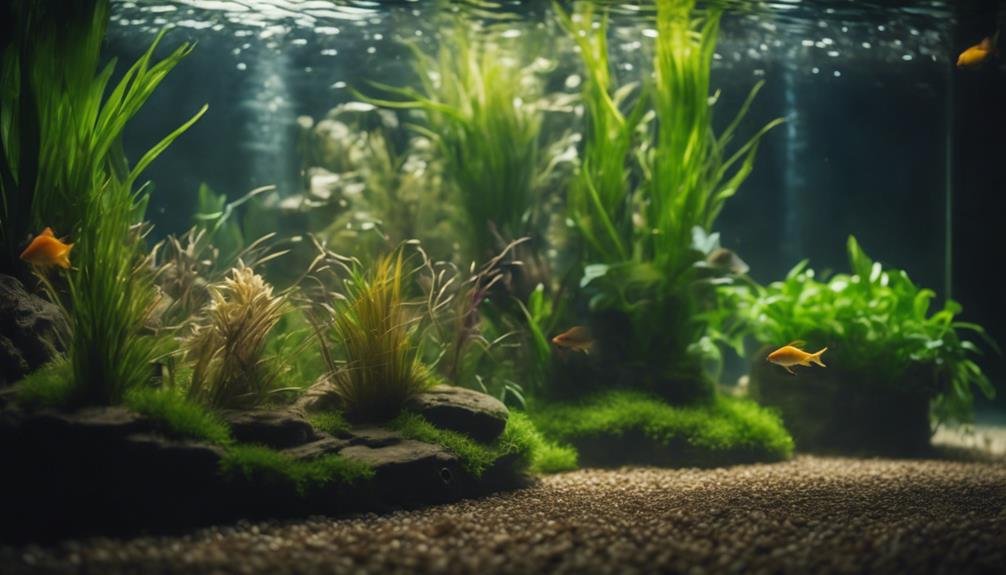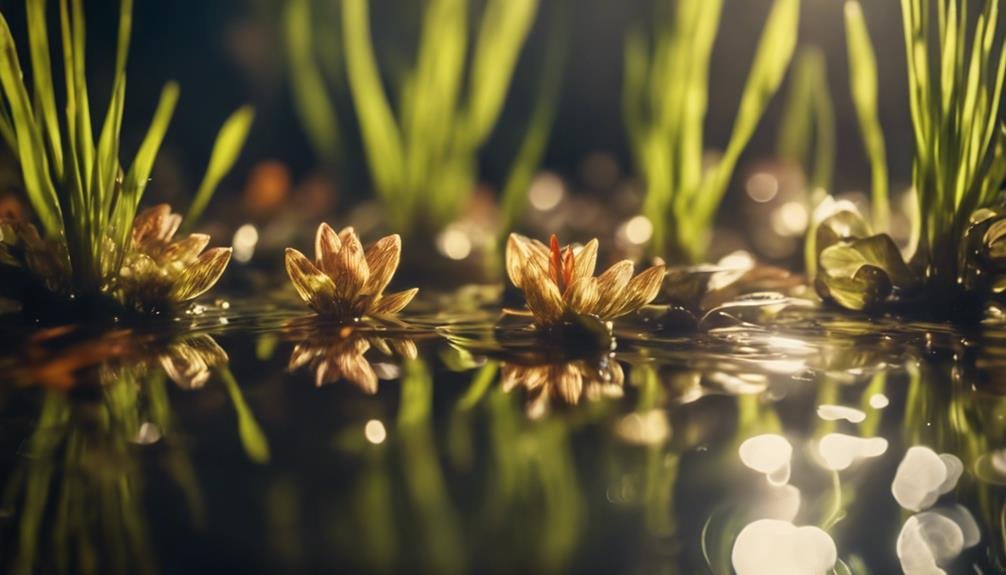To protect pond plants during winter, it's essential to first determine their hardiness level: tropical, semi-hardy, or hardy.
Tropical plants require an indoor aquatic environment with controlled conditions, such as an aquarium filled with dechlorinated water and adequate lighting and temperatures.
For hardy plants, setting up an outdoor sheltered storage space with insulation using materials like old windows or hay bales is ideal.
Semi-hardy plants may struggle in extreme cold, so regular monitoring is crucial. Proper ventilation is necessary to prevent the growth of mold and rot.
When spring arrives, gradually reintroduce the plants to the outdoor pond, allowing them time to acclimate to their natural habitat.
For detailed information on preparing plants for storage and reintroducing them, further exploration is recommended.
Assessing Plant Needs
Assessing the needs of pond plants before winter is crucial to ensure they survive the cold months. Different plants have varying requirements for overwintering, with some able to withstand freezing temperatures while others need to be stored indoors for protection.
It's essential to research each plant's specific needs to provide the best care possible.
Start by identifying the plants in the pond and categorizing them as tropical, semi-hardy, or hardy. Tropical plants like water lilies and lotus can't survive freezing temperatures and should be brought indoors. Semi-hardy plants may endure mild winters but could struggle in severe cold. Hardy plants, such as certain marginal plants or oxygenators, can typically stay in the pond throughout winter.
Once you have determined which plants require protection, plan accordingly. Some may need trimming before winter sets in, while others can be left untouched. Prepare suitable storage areas, like aquariums or tubs, for plants that need indoor shelter.
Taking the time to assess each plant's needs will help ensure a thriving pond when spring arrives.
Preparing Outdoor Storage
When preparing outdoor storage for pond plants during winter, it's important to note that while some plants need indoor care, hardy varieties can thrive outside with proper precautions. To shield them from harsh weather conditions, setting up a sheltered area is essential. This can be done using a simple structure like a cold frame or mini-greenhouse made from materials such as old windows or plastic sheeting mounted on a wooden frame.
The setup involves creating a protective layer with different components for effective insulation and weather protection. A raised platform made of wood, bricks, or hay bales serves as the base to keep the plants insulated. Adding wooden or plastic sheeting around the sides acts as a barrier against wind and rain. For the top cover, using old windows or greenhouse plastic allows light to enter while shielding the plants. To provide insulation, materials like hay, leaves, or bubble wrap can be added within the structure.
Placing the potted plants inside this sheltered area, with the possibility of embedding the pots into the insulated base for extra protection, helps them endure the winter months. Proper ventilation is crucial to prevent mold and rot from developing.
Indoor Aquatic Environment

Setting up an indoor aquatic environment is a great way to protect pond plants during the winter. To create this environment, you'll need a large aquarium or plastic container filled with dechlorinated water. Place it in a spot with bright, indirect sunlight, and consider adding fluorescent bulbs for extra light if needed.
When transitioning the pond plants indoors, clean off any debris and trim away dead or damaged parts before placing them in the water. Secure the plants with gravel or rocks to prevent them from floating, except for floating plants like water lettuce that can stay on the surface.
Maintaining a cool water temperature of 50-60°F is crucial, so you may need an aquarium heater. Regular water changes of 25-30% every week or two will help keep the plants healthy.
With these steps and the right conditions, you can successfully keep hardy pond plants indoors until spring.
Monitoring Stored Plants
It's vital to regularly check on our overwintered pond plants to ensure their well-being during the dormant season. By carefully observing for any signs of distress, such as discolored or wilting leaves, soft stems, mold growth, excessive dryness, or pest infestations, we can address issues promptly.
Taking action, such as increasing humidity, adjusting light exposure, or using fungicides when needed, can help prevent further deterioration. Regularly misting the plants and trimming away any damaged parts can also aid in maintaining their health.
With attentive care, we can successfully nurture our beloved aquatic plants through the winter, ready to flourish once spring arrives.
Spring Pond Reintroduction

Once we finish monitoring our pond plants during the winter, we eagerly look forward to reintroducing them to their aquatic home in the spring. As the weather gets warmer and the risk of frost decreases, we'll gradually acclimate our plants to the outdoor conditions.
This process, called 'hardening off,' involves slowly exposing the plants to more sunlight and cooler temperatures over a period of one to two weeks. To start, we'll take the plants out of storage and carefully check for any signs of disease or damage. Then, we'll place them in a shaded and protected area for the first few days.
Over the following week or two, we'll gradually increase their exposure to direct sunlight. Once the plants have fully adjusted and the nighttime temperatures stay above 50°F (10°C), we'll reintroduce them to the pond.
It is crucial to reintroduce the plants slowly to reduce transplant shock and ensure a smooth transition. We'll keep a close eye on them as they acclimate, providing the necessary care to help them thrive in their aquatic environment once again.
Conclusion
By preparing adequately and staying vigilant, we can look forward to the return of our beloved aquatic plants in the vibrant beauty of spring. As winter gives way to the new season, reintroducing them to our revitalized pond, our masterpiece of nature, will be a satisfying reawakening that affirms our devoted care.
Winter can be a challenging time for pond plants, as the cold temperatures can pose a threat to their health. By taking the time to protect and store them properly, we ensure their survival and flourishing return when the weather warms up. Monitoring their condition throughout the winter months is crucial, as it allows us to address any issues promptly and make adjustments as needed.
When storing pond plants for winter, it's essential to choose a location that provides adequate protection from the elements. This could be a greenhouse, a garage, or even a sheltered area in your home. Insulating the plants with straw or mulch can help maintain a stable temperature and protect them from frost damage.
In addition to providing physical protection, it's essential to continue caring for the plants during the winter months. This includes checking on their water levels, ensuring they receive enough light, and monitoring for any signs of disease or pests. By staying proactive, we can help our pond plants thrive during the colder months and ensure they're ready to flourish once spring arrives.
As we eagerly anticipate the return of our pond plants in the spring, let's take the time to appreciate the beauty they bring to our outdoor spaces. Their resilience and grace serve as a reminder of the wonders of nature and the joy of tending to a living, breathing ecosystem.

